Leveraging Nmap for Network Discovery and Vulnerability Assessment: A Comprehensive Lab Walkthrough#
Leveraging Nmap for Network Discovery and Vulnerability Assessment: A Comprehensive Lab Walkthrough#
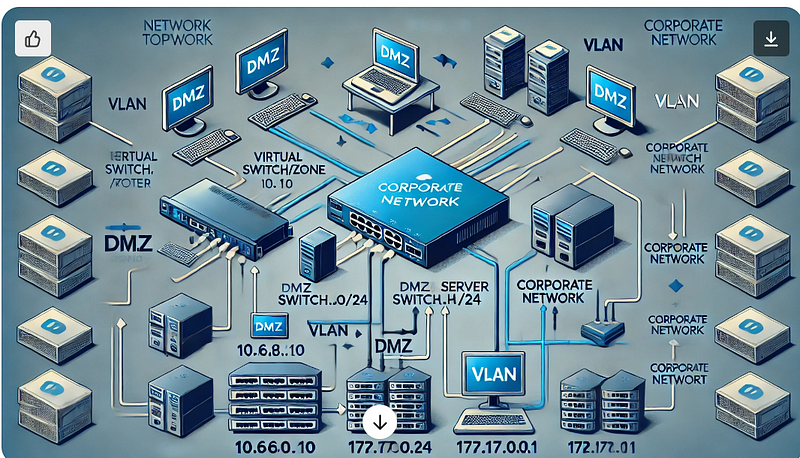
Introduction
Network security is an ongoing challenge, with new vulnerabilities and attack vectors emerging constantly. Nmap, a network discovery and auditing tool, is one of the most effective tools for cybersecurity practitioners to probe network assets. This lab walkthrough will detail how to use Nmap for discovering network hosts, fingerprinting operating systems, and detecting exposed services — skills essential for both red and blue teams.
Background / Scenario#
A Wireshark capture shows unusual activity on a machine on the 10.6.6.0 DMZ network. You’ve been asked to do some active recon on the machine to determine what services it may be offering and if there are vulnerable applications that could present security issues. The IP address of the suspicious computer is 10.6.6.23. You have access to a Kali Linux system on the 10.6.6.0 network.
scope#
In this lab setup, we’ll be working within a virtualized cisco environment using Kali Linux. Our target network is a typical corporate configuration with a range of IP addresses from 10.6.6.0/24. This walkthrough will explore multiple scan types, including discovery, service identification, and NSE scripts for SMB enumeration.
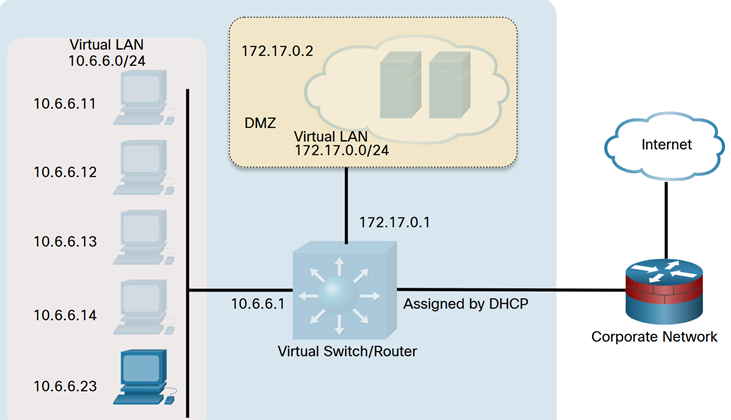
Environment Setup and Command Basics
To begin, ensure your kali environment is ready for the scan. After logging into your Kali instance, verify your network configuration:
This ensures your network interface is up, and you’re connected to the 10.6.6.0/24 subnet. Next, check that Nmap is installed and up-to-date:
nmap -V
- Log into the Kali system with the username kali and the password kali*.* You are presented with the Kali desktop.
- Open a terminal window.
- Verify that Kali has an interface in the 10.6.6.0/24 network using the ifconfig command.
- Use the nmap -V command to verify that Nmap is installed and to display the Nmap version. The output will be similar to what is shown below.

Exploring Nmap Options
Running nmap -h provides a comprehensive list of options and flags. For quick reference, here’s a summary of the core options we’ll use in this lab:

Part 1: Host Discovery and Initial Scans#
Discovery Scan#
To begin reconnaissance, let’s discover active hosts within our network:
nmap -sn 10.6.6.0/24
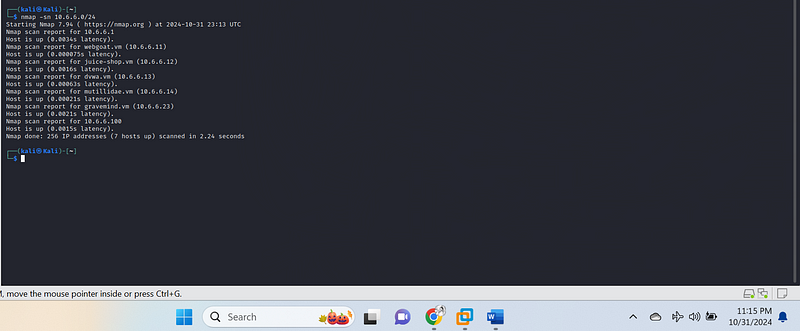
The output from your nmap -sn 10.6.6.0/24{.markup–code
.markup–p-code} scan shows a ping sweep on the subnet
10.6.6.0/24{.markup–code .markup–p-code}, where Nmap performed a
scan to check for live hosts without scanning individual ports (since
-sn{.markup–code .markup–p-code} skips port scans). Here’s a
breakdown of the results:
Active Hosts:Seven hosts are up, which includes:
10.6.6.1{.markup–code .markup–li-code} - This is likely the gateway or virtual switch/router, as it usually has the.1{.markup–code .markup–li-code} address in a subnet.10.6.6.11{.markup–code .markup–li-code} (webgoat.vm{.markup–code .markup–li-code}) - A VM likely running the WebGoat application, a common testing tool for security training.10.6.6.12{.markup–code .markup–li-code} (juice-shop.vm{.markup–code .markup–li-code}) - Probably running OWASP Juice Shop, an application used for practicing security attacks.10.6.6.13{.markup–code .markup–li-code} (dvwa.vm{.markup–code .markup–li-code}) - Potentially hosting DVWA (Damn Vulnerable Web Application), another security training tool.10.6.6.14{.markup–code .markup–li-code} (mutillidae.vm{.markup–code .markup–li-code}) - Likely running Mutillidae, another intentionally vulnerable application.]{#207c}10.6.6.23{.markup–code .markup–li-code} (gravemind.vm{.markup–code .markup–li-code}) - Could be hosting another specific application, but the purpose isn’t clear from this name alone.10.6.6.100{.markup–code .markup–li-code} - No hostname information, possibly another device or VM on the network.
This command uses a “ping scan” to identify active hosts by sending ICMP echo requests. Active IP addresses will respond, giving us a list of targets. For this lab, assume that IP 10.6.6.23 has been identified as a potentially vulnerable host.
Default TCP Scan#
Now that we’ve identified a target, let’s investigate open ports using a default TCP scan:
nmap 10.6.6.23


Each of these open ports represents a potential access point for an attacker, and understanding these services helps evaluate the security posture of 10.6.6.23.
Part 2: Deepening Our Scan with OS and Version Detection#
Operating System Detection#
To better understand the host, we’ll attempt to detect its operating system:
sudo nmap -O 10.6.6.23
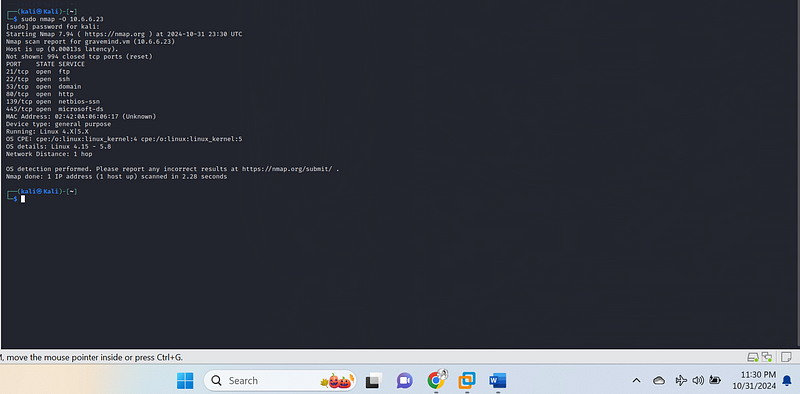
This Nmap scan used the -O{.markup–code .markup–p-code} flag to
perform OS detection on 10.6.6.23{.markup–code .markup–p-code}
(gravemind.vm), which successfully identified the host as running a
Linux operating system, specifically versions between 4.15 and
5.8. Here's a breakdown of the results:
- Open Ports: Six TCP ports are open, supporting services like FTP, SSH, DNS, HTTP, and SMB (NetBIOS and Microsoft-DS).
- MAC Address: Shows
02:42:0A:06:06:17{.markup–code .markup–li-code}, which could be helpful for device identification, though it appears not associated with a known vendor. - Device Type: Classified as “general purpose,” suggesting this is likely a standard server rather than a specialized device like a router or IoT equipment.
- OS Detection: Nmap OS detection uses various fingerprints to estimate the operating system. Here, it accurately recognizes a Linux OS kernel within the 4.x to 5.x range.
- Network Distance: Reported as “1 hop,” indicating that the scan is likely being run within the same local network or subnet, as the device is just one step away in network terms.
These findings are useful for understanding the device type, its likely OS environment, and potential vulnerabilities specific to Linux kernel versions in the 4.x and 5.x series. If you’d like to dive deeper, we could use further Nmap scripts or other tools to enumerate services in detail or check for specific vulnerabilities on each open port.
Service Version Detection#
For a more granular look at the host’s services, we’ll probe specific ports with version detection:
nmap -v -p21 -sV -T4 10.6.6.23
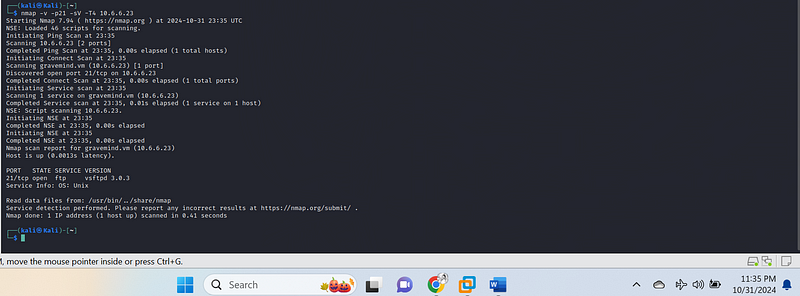
In this Nmap scan, the command used -v -p21 -sV -T4{.markup–code
.markup–p-code} to gather detailed information on port 21 (FTP) for
the target 10.6.6.23{.markup–code .markup–p-code}. Here’s a
breakdown of the results:
- Verbose Mode (-v): Provides detailed output about each scan phase, showing steps as they happen.
- Specified Port (-p21): Limits the scan to only port 21 (FTP) to focus on this service alone.
- Service Version Detection (-sV): Identifies the service version running on an open port. Here, it detects vsftpd 3.0.3, a common FTP server.
- Aggressive Timing Template (-T4): Speeds up the scan without compromising reliability, useful for a faster scan in non-intrusive environments.
Scan Findings:
- Port Status: Port 21 is open, running FTP.
- Service and Version: The FTP service is identified as vsftpd 3.0.3.
- OS Information: The service appears to run on a Unix-based operating system, inferred from the service response.
This level of detail can help determine if vsftpd 3.0.3 has known vulnerabilities or misconfigurations that could be exploited. Further steps could include testing for default FTP credentials or checking if anonymous login is allowed.
Aggressive Scan with -A Option#
To combine these scans and maximize information retrieval, use an aggressive scan:
nmap -p21 -sV -A 10.6.6.23
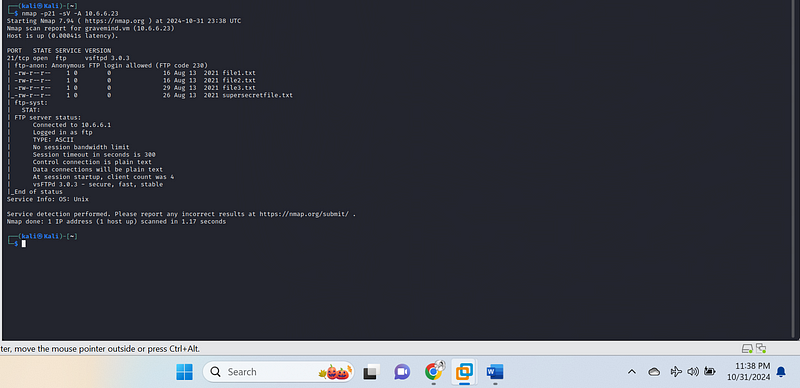
Your Nmap scan indicates that the target host
(gravemind.vm{.markup–code .markup–p-code} at
10.6.6.23{.markup–code .markup–p-code}) is running an FTP server
(vsftpd 3.0.3) and allows anonymous access. Here’s a brief breakdown of
the findings:
Scan Summary of the above
- Host Status: Up (with low latency)
- Open Port:
- 21/tcp (FTP):
- Service: vsftpd 3.0.3
- Anonymous Access: Allowed (FTP code 230)
Files Accessible via Anonymous FTP:
file1.txt{.markup–code .markup–li-code} (16 bytes)file2.txt{.markup–code .markup–li-code} (16 bytes)file3.txt{.markup–code .markup–li-code} (29 bytes)supersecretfile.txt{.markup–code .markup–li-code} (26 bytes)
FTP Server Info:#
- Connected to
10.6.6.1{.markup–code .markup–li-code} - Logged in as
ftp{.markup–code .markup–li-code} - Transfer type: ASCII
- Control and data connections are unencrypted (plain text)
- Session timeout: 300 seconds
Potential Risks:#
- Anonymous FTP Access: Allows unauthorized users to access potentially sensitive files.
- Plain Text Connections: No encryption, exposing data to interception.
Recommendations:#
- Disable Anonymous FTP Access to prevent unauthorized file access.
- Implement Secure FTP (SFTP/FTPS) to encrypt connections.
- Regularly Review Files on the FTP server for sensitive information.
Part 3: Running NSE Scripts for SMB Enumeration#
The Server Message Block (SMB) protocol is a network file sharing protocol supported on Windows computers and by SAMBA on Linux. SMB enables applications to read and write files or request services over a network. Open public shares or shared devices such as print servers on a network, can be accessed through SMB.
The earlier scan of open ports on the target computer indicates that the SMB ports 139 and 445 are open. Find more information on these ports using the -A and -p command options. The -A option executes several functions including running the default scripts. Specify more than one port to scan by listing them separately with a comma between them
nmap -A -p139,445 10.6.6.23
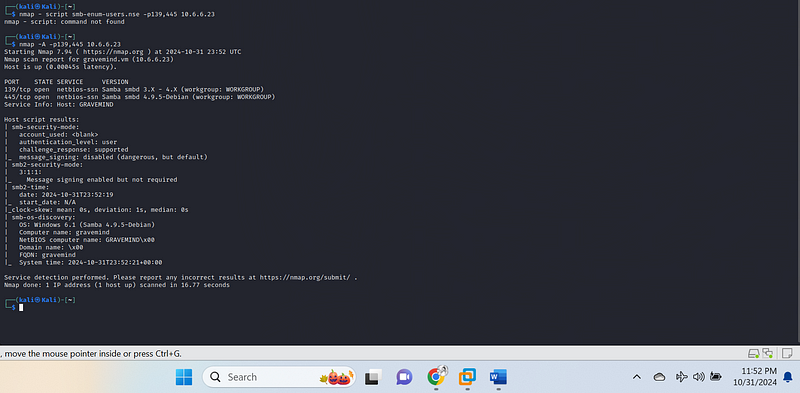
Results Summary#
- Host Status:
The host (10.6.6.23) is up, with a low latency of 0.00045 seconds, indicating it’s reachable and responsive.
Open Ports:
Port 139/tcp:
- State: Open
- Service: NetBIOS Session Service (part of SMB)
- Version: Samba smbd 3.X — 4.X, indicating it supports SMB versions 3.x to 4.x.
Port 445/tcp:
- State: Open
- Service: NetBIOS Session Service
- Version: Samba smbd 4.9.5-Debian, showing a specific version of the Samba service used to handle SMB requests.
Additional Information#
Service Info:
Host: GRAVEMIND
Workgroup: WORKGROUP
Security Mode:
- The
smb-security-mode{.markup–code .markup–li-code} section shows:
Account Used: <blank>{.markup–code .markup–p-code}, suggesting
no specific account was used for the scan.
Authentication Level: user{.markup–code .markup–p-code}, which
indicates that user-level access is required.
Challenge Response: Supported, meaning the service can use challenge-response authentication.
Message Signing: Disabled, which is considered a security risk (as it can expose SMB traffic to man-in-the-middle attacks).
SMB2 Security Mode:
Message signing is enabled but not required, which can also pose a security risk.
OS Discovery:
- Detected Operating System: Windows 6.1 (Samba 4.9.5-Debian), suggesting the system is running a version of Samba emulating a Windows environment.
- Computer Name: GRAVEMIND
- Domain Name:
<blank>{.markup–code .markup–li-code}, indicating that the system is not part of a domain.
Time Information:
The SMB service provides the current date and time as well as system time synchronization information.
Conclusion#
The scan reveals that the target machine is running Samba, likely functioning as a file and print server. The presence of open SMB ports with some security features disabled poses potential security risks, making it essential to implement proper configurations to secure the service
Enumerating SMB Users#
Nmap contains the powerful Nmap Scripting Engine (NSE), which enables the programming of various Nmap options and conditional actions to be taken as a result of the responses. NSE has built-in scripts that enumerate users, groups, and network shares. One of the more commonly used scripts for SMB discovery is the smb-enum-users.nse script. Use the Nmap NSE script with the command:
nmap --script smb-enum-users.nse -p139,445 10.6.6.23
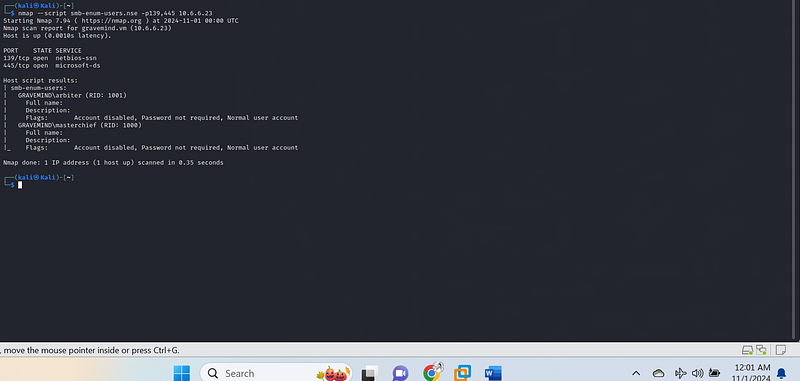
Results Summary
- Host Status:
- The host (10.6.6.23) is up and responsive, with a latency of 0.0010 seconds.
- Open Ports:
- Port 139/tcp: Open and associated with the NetBIOS Session Service.
- Port 445/tcp: Open and associated with Microsoft Directory Services (another SMB-related service).
User Enumeration Results#
The script successfully enumerated user accounts on the SMB service. Here are the details:
- User: GRAVEMIND\arbiter
- RID: 1001 (Relative Identifier, a unique number assigned to the user in the context of the domain)
- Flags
- Account disabled: Indicates that this user account is currently disabled.
- Password not required: This suggests that a password is not required to log in to this account.
- Normal user account: Indicates this account has standard user privileges, not elevated privileges.
- User: GRAVEMIND\masterchief
- RID: 1000.
- Flags:
- Account disabled: This user account is also disabled.
- Password not required: Similarly, a password is not required to log in to this account.
- Normal user account: This is also a standard user account.
Conclusion
The enumeration reveals two user accounts on the target machine (GRAVEMIND), both of which are disabled and configured to not require passwords. This setup may indicate poor security practices, as disabled accounts still being enumerated can present risks if an attacker can enable them or exploit weaknesses in the SMB service.
Overall, the results highlight potential vulnerabilities in the configuration of user accounts, making it crucial for system administrators to regularly review and tighten security settings on SMB services.
The output shows any usernames found on the SMB server, helping identify potentially exposed accounts. Access to usernames can be useful for brute force attacks, making it essential to secure user lists.
Enumerating Shared Directories#
To see if the host shares directories, A serious security concern is the existence of publicly shared directories (folders). You can enumerate the network shares using another NSE script, smb-enum-shares.nse. To discover shared directories on the target computer. Use the Nmap share enumeration script with the command:
nmap — script smb-enum-shares.nse -p445 10.6.6.23
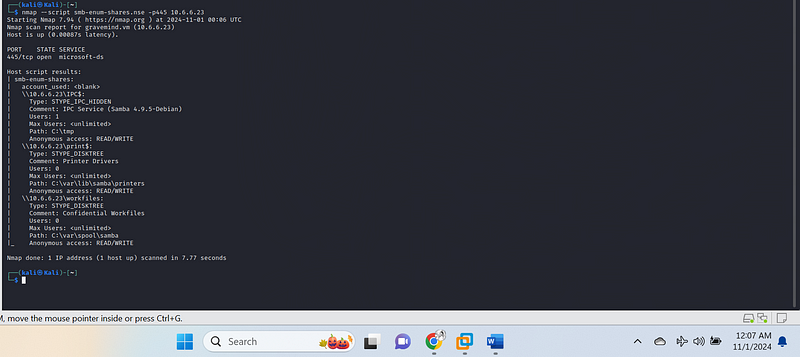
Results Summary#
- Host Status:
- The host (10.6.6.23) is up and responsive, with a latency of 0.00087 seconds.
- Open Port:
- Port 445/tcp: Open and associated with Microsoft Directory Services (again, indicating an SMB service).
Share Enumeration Results
The script successfully identified three shared directories on the SMB service:
- Share: \\10.6.6.23\IPC$
- Type: STYPE_IPC_HIDDEN (Inter-Process Communication, typically hidden from normal enumeration).
- Comment: IPC Service (Samba 4.9.5-Debian).
- Users: 1 (indicating at least one user is connected).
- Max Users: <unlimited> (indicating no limit on user connections).
- Path: C:\tmp (the file system path for this share).
- Anonymous Access: READ/WRITE (indicating that anyone can access this share with read and write permissions).
- Share: \\10.6.6.23\print$
- Type: STYPE_DISKTREE (a standard disk share).
- Comment: Printer Drivers.
- Users: 0 (indicating no current users are connected).
- Max Users: <unlimited>.
- Path: C:\var\lib\samba\printers.
- Anonymous Access: READ/WRITE (indicating open access for any user).
- Share: \\10.6.6.23\workfiles
- Type: STYPE_DISKTREE.
- Comment: Confidential Workfiles.
- Users: 0.
- Max Users: <unlimited>.
- Path: C:\var\spool\samba.
- Anonymous Access: READ/WRITE.
Conclusion
The scan revealed three shares on the target SMB service, with two of them (print$ and workfiles) indicating that they allow anonymous access with read/write permissions. This is a significant security risk, as it enables any user to access, modify, or delete files in these shares without authentication.
- IPC$: Typically used for administrative purposes, but allowing anonymous access can lead to unauthorized access.
- print$: Sharing printer drivers could expose sensitive information if unauthorized users access it.
- workfiles: The comment suggests that it contains confidential data, which should not be openly accessible.
Overall, the findings suggest that the SMB service on the target system has misconfigured shares, making it crucial to review and tighten access controls to prevent unauthorized access and potential data breaches. Proper configurations should restrict anonymous access and enforce authentication for sensitive shares.
If public or anonymous shares are enabled, unauthorized users might gain read/write access to sensitive files. This is a serious risk, especially in internal networks, where such shares can provide a foothold for lateral movement.
Reflection on Findings
This lab demonstrates how Nmap provides critical insights into network vulnerabilities. Key takeaways include:
- Nmap’s Power in Recon: Both blue and red teams benefit from Nmap’s ability to map out network assets and assess their exposure.
- Security Implications of Open Ports and Services: Each exposed service, such as FTP or SMB, has associated risks. Controlling access to these ports and implementing access restrictions can mitigate these vulnerabilities.
- Ethical and Practical Considerations: While Nmap is an invaluable tool, its use should be governed by ethics and proper authorization, especially given its ability to expose sensitive details about a network.
By Kiplagatkelvin{.p-author .h-card} on October 31, 2024.
Canonical link{.p-canonical}
Exported from Medium on February 13, 2025.
